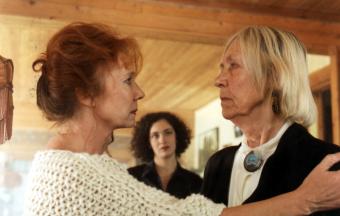 |
ZWETY KALENDULY
Die Blüten der Calendula
Marigold
in flower
Sergej Sneschkin
Rußland 1998
Produktion:
Lenfilm, Studio ‘Barmalej’, PK ‘Slowo’, Roskomkino
Weltvertrieb: Lenfilm, St. Petersburg
Tel. (7812) 8268341, Fax 2328374
Buch:
Michail Konowaltschuk, Sergej Sneshkin Kamera: Artur Melkumjan, Alexander
Ustinow Schnitt: Elena Karelina
Darsteller: Era Siganschina, Marina Saloptschenko, Ksenija Rappoport
Sprache: Russisch
Format:
35 mm, 1:1.66, Farbe Länge: 120 Minuten, 24 B/sek. |
| Alles
wie bei Tschechow: Drei Schwestern, ein großer Garten und die ewige
Frage: Wie soll man weiterleben? Die Entfernung zwischen Wollen und Können
vermögen sie einfach nicht zu bewältigen. Das Leben geht seinen
Gang, und jede der drei Protagonistinnen träumt vom Glück, jede
kämpft auf ihre Weise. Serafima sieht nur noch eine Aufgabe: die
Mutter davon abzuhalten, das Haus und den Garten – die letzte Hoffnung
bei der jetzigen Armut der Familie – zu einem Museum für den
verstorbenen Stalinpreis-Dichter Protassow zu machen. Die drei Töchter,
die alle aus verschiedenen Ehen stammen, nehmen die Situation unterschiedlich
auf: die eine kann nicht mit der Realität fertig werden; die andere
wünscht den Tod der Großmutter herbei und möchte zu ihrem
Vater nach Amerika auswandern; die dritte ist eher für den Erhalt
des Familiennestes. Erst der reiche Unternehmer Russezkij als potentieller
Käufer der Datscha bringt Bewegung und Hoffnung in die erstarrten
Leben… Ein intelligenter und witziger Film im Geiste Tschechows,
der voller Melancholie den Zerfall einer einstmals privilegierten Familie
der Sowjetzeit beschreibt. |
These flowers could elegantly
and beautifully be called calendula, or simply marigolds. They grow
like weeds around summerhouses. They look pretty but they could just
as well be torn out. In the Soviet Union people thought similarly about
pre-revolutionary aristocrats – they were considered useless decoration.
In the Soviet era, too, an upper class emerged to which the poet Protassov
belonged. When the Soviet Union ceased to exist, the poet also died.
He left behind his 80-year-old wife, his daughter Serafima and three
grandchildren – Anna, Elena and Mascha. It is like a Chechov play:
Three sisters, a big garden and the eternal question – how do we
continue to live? They don’t seem capable of overcoming the gap
between ‘I want’ and ‘I can’. Life goes on, and
each of the three protagonists dream of happiness, fights her own battles.
Serafima sets her eyes on one single task: to keep her mother from transforming
house and garden into a museum dedicated to the deceased Protassov.
The property is their last hope in the present state of poverty. Her
three daughters, born in three different marriages, deal with the situation
in various ways. When, out of the blue, the affluent entrepreneur Russezkij
appears as a potentional buyer of the ‘datscha’, everyday
life falls apart, hopes disappear and reemerge... This is an intelligent,
funny and effective film with lavish costumes and all the elements of
a tragicomedy. It is about the post-Soviet aristocracy, about the people
who are like the flowers – although they could called both marigolds
and calendula.
|
Biofilmographie
/ Biofilmography
Sergej Sneshkin wurde am 10. Oktober 1954 in Leningrad geboren
und studierte zunächst am Krupskaja-Kulturinstitut. Nach seinem Studienabschlu▀
arbeitete ein Jahr lang in einer Fabrik. 1976 wurde er am WGIK, der Moskauer
Filmhochschule, in die Klasse von E.G. Dsigan aufgenommen. Er beendete
seine Studien 1981 mit seinem Abschlu▀film Schtschenok (Das Hündchen,
Kurzfilm) und begann zuerst als Regieassistent, später als Regisseur
bei Lenfilm zu arbeiten. Seit 1991 ist Sneshkin künstlerischer Leiter
des Kinderfilmstudios Barmalej und Hauptredakteur des Produzentenzentrums
bei Lenfilm.
Sergej Sneshkin was born on October 10th, 1954 in Leningrad
and studied at the Krupskaja Cultural Institute. After graduation he worked
for a year in a factory. In 1976 he was accepted at the WGIK, the Moscow
Film School into E.G. Dsigan's class. He finished his studies in 1981
with a graduation film Schtschenok (The Little Dog) and began to work
as an assistant director at Lenfilm. Since 1991 Sneshkin has been artistic
director of the children's film studio Barmalej and main editor of the
producers' centre at Lenfilm.
Filme
1985: Ej, na linkore (Kurzfilm). 1987: Petrogradskije Gawroschi. 1988:TschePe
raionnogo masschtaba. 1991: Newoswraschtschenez.
1999: Zwety Kalenduly. |